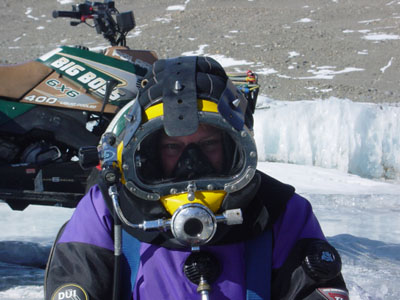Home|Glossary|Links|Journal|Maps
Gearing
Up
It's
cold. It's dark. There's only one way out. Diving in the perennially
ice-covered lakes of the Dry Valleys presents a lot of challenges.
So how did research divers Ian Hawes, Donna Sutherland, and Maria
Uhle do it? They started by layering up.
First they put on a set of polypropylene
long underwear. On top of this, they wore a jumpsuit made of synthetic
down and known as Weasel Extreme.
"Synthetic down is the same
kind of material you'd find in a cold weather sleeping bag",
explains Maria, a professor at the University of Tennessee-Knoxville.
A waterproof membrane dry suit went on top of the Weasel Wear. Although
dry suits come in different designs, a typical one will have special
seals on the wrists and neck to keep water out and a zipper across
the back going from shoulder to shoulder to provide the entry way
into and out of the suit. Another person had to help the divers zip
up.
On their hands, the divers wore polypropylene
glove liners and pulled on rubber gloves that, like the dry suit,
had seals to keep water out. Some of the divers also wore booties
on top of their suit to give their feet extra insulation and padding.
Fins were a must since they helped the divers move more quickly through
the water.
Perhaps one of the most specialized
parts of the Dry Valleys' dive team equipment, however, was the team's
headgear. Recreational divers tend to carry their air around with
them in scuba tanks on their back, and they breathe into and out of
a regulator they keep in their mouths. Their air supply is therefore
limited, underwater communication is difficult, and underwater to
surface communication is impossible.
|
The dive team in contrast made
use of band masks. This is a mask that covers the whole of your
face rather than just your nose and eyes like a normal dive
mask, explains Donna, a researcher with New Zealand's National
Institute of Water and Atmospheric Research (NIWAR).
It consists of a steel and fiberglass frame that holds a plastic
front glass. On the inside of this front glass is a rubber gasket
that forms a watertight seal against the diver's face, enclosing
his or her eyes, nose, and mouth. Air enters the mask through
a valve on the side. The mask is held to the diver's face by
a rubber hood.
"Band masks are warmer
than normal dive masks and allow quite sophisticated air and
communications equipment to be incorporated", says
Ian, who like Donna is a researcher with NIWAR.
For the Dry Valleys dives, an air tube linked the mask to an
air supply on the surface and gave the divers a virtually inexhaustible
supply of air. A microphone, earphone, and communications wire
in the air tube allowed the divers to actually talk underwater
with people on top of the ice.
"Water does slowly seep
into the bank masks", notes Ian, "but it can
be blown out and does not pose an undue cold risk".
|
 Donna
and Maria help
Donna
and Maria help
Ian get his dive hood on |
|

Maria
with her band mask and hood on
|
A last piece of
equipment that the divers needed may seem counterintuitive at
first. If a diver dressed in all the aforementioned gear lowered
him or herself into a dive hole, he or she wouldn't be able
to dive. That's because the person would just float. Although
the gear adds weight to the diver, it also adds a lot of volume,
mostly as air spaces. This makes the divers less dense (or more
buoyant) than the surrounding water.
To help counteract this floating
tendency, members of the Dry Valleys' dive team wore a 40 pound
weighted vest. Also, increasing water pressure pushing down
on the divers as they descended reduced the volume of air in
their suits nd helped them sink.
|
Photos courtesy of Karen Cozzetto.
Next >>


